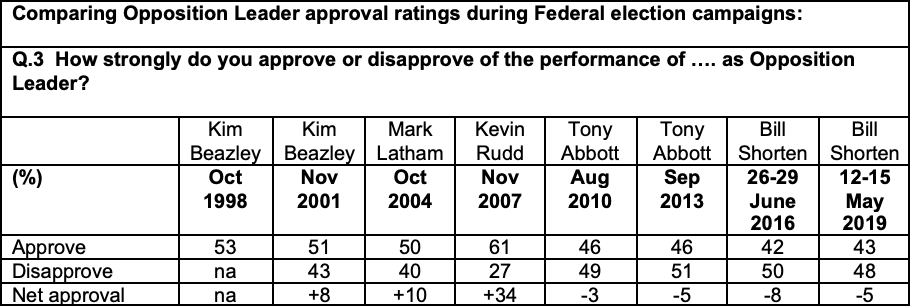Labor retains lead but election race tightens
The national poll of 1,842 respondents (who are all enrolled and certain to vote), shows the Labor Party on 51% (down one point since the mid-campaign poll on 1-4 May 2019), with the Coalition on 49% (up one point since 1-4 May), based on 2016 election preferences.
Interviewing was undertaken from Sunday 12 May to Wednesday 15 May, with two further campaign days remaining before Election Day on 18 May.
“The poll findings suggest that this is a close election with Labor narrowly ahead. While the results show a 1.4% swing against the Coalition Government since the July 2016 election, this assumes a universal national swing, which is unlikely to happen. There are many parliamentary seats where the race between the candidates is very close and the outcome in each of these electorates will determine who gets to form the next government. However, despite the close two party-preferred figures, 55% think Labor will win,” Ipsos Director, Jessica Elgood, said.
The two-party stated preference vote also shows the Labor party on 51% (down one point since 1-4 May) and the Coalition on 49% (up one point since 1-4 May).
The Coalition’s first preference vote is 39% (up three points since 1-4 May), with Labor on 33% (unchanged since 1-4 May). The Greens primary vote is 13% (down one point since 1-4 May), One Nation is on 4% (down one point since 1-4 May), the Centre Alliance is on 1% (unchanged since 1-4 May), the United Australia Party is on 3% (unchanged since 1-4 May) and others are on 8% (unchanged since 1-4 May).
Seven per cent of respondents are undecided (unchanged since 1-4 May). These are excluded from the two-party stated preference figures and from the primary vote figures.
Key findings
- Leaders’ approval ratings: Prime Minister Scott Morrison’s approval rating is 48% (up one point since 1-4 May), and his disapproval rating is 43% (down one point since 1-4 May). Opposition Leader Bill Shorten’s approval rating is 43% (up three points since 1-4 May), and his disapproval rating is 48% (down three points since 1-4 May).
- Preferred Prime Minister: 47% prefer Scott Morrison as the Prime Minister (up two points since 1-4 May); 40% prefer Bill Shorten (unchanged since 1-4 May).
- Who’s going to win: 55% believe Labor will win this election; a third (32%) believe the Coalition will win.
- Preferences: Two-party vote, based on stated preferences: Labor 51% (down one point since 1-4 May), Coalition 49% (up one point since 1-4 May). Two-party vote, based on 2016 election preferences: Labor 51% (down one point since 1-4 May), Coalition 49% (up one point since 1-4 May) First preferences: Labor 33% (unchanged since 1-4 May), Coalition 39% (up three points since 1-4 May).
- Early voters: 30% have already voted or intend to do so before Election Day.
Leaders’ approval and preferred Prime Minister
Scott Morrison’s approval rating is 48% (up one point since 1-4 May), and his disapproval rating is 43% (down one point since 1-4 May). The proportion that say they ‘neither approve nor disapprove’ or ‘don’t know’ (9%) is unchanged since 1-4 May. These ratings are similar to those of Malcolm Turnbull prior to the last Federal election.
There has been a small marginal improvement in Bill Shorten’s approval rating, with the Opposition Leader’s approval at 43% (up one point since 1-4 May). His disapproval rating is unchanged, at 48%. This gives a net approval of -5 (up six points since 1-4 May).
While neither Morrison’s nor Shorten’s leader ratings are historically strong, the trend data shows that no incumbent has won from a position of a net approval rating of only +5, but an opposition leader (Tony Abbott) has won with a net approval rating of -5.
Scott Morrison remains the preferred Prime Minister, with 47% (up two points since 1-4 May). Those preferring Bill Shorten as PM is unchanged at 40%. This is a stronger position than held by John Howard going into both the 1998 and 2004 Federal elections, which he won as incumbent Prime Minister.


Who is going to win?
A majority (55%) of the public believes Labor will win this election (up three points since 1-4 May); a third (32%) believe the Coalition will win (down one point since 1-4 May); and 13% mention another party or say they don’t know.
The public’s expectation of who will win the next Federal election has been correct for each of the last seven Federal elections.
Among Coalition voters, half (52%) believe the Coalition will win, however 39% think Labor will form the next government. In contrast, 78% of Labor voters think the Labor party is going to win the Federal election (up six points since 1-4 May), and only 15% of Labor voters believe the Coalition will win.

Early voters
Thirty per cent of the electorate says they have already cast their vote or will do so before Election Day itself (25% saying they’ve already voted, and a further 6% saying they still intend to do so). Early voters are more likely to be older, and from medium and lower income households.
Given the age profile of early voters, their primary vote is more likely to go to the Coalition (41% among those who have already cast their vote, and 50% among those still intending to do so).
The two party preferred figures for those who have already voted is 53% Coalition and 47% Labor, and among those still intending to vote early is 59% Coalition and 41% Labor.
Poll Profile
Fieldwork dates: 12-15 May 2019 Sample size: 1,842 respondents
Sample: National, aged 18+, 46% of sample comprised mobile phone numbers.
Method: Telephone, using random digit dialling.
Statistical reliability: ±2.3% is the maximum margin of sampling error that might apply to this sample
Analysis: The data is based on all those enrolled to vote and certain to vote. The data has been weighted to reflect the population distribution.


